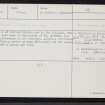St Andrews
Textile
Site Name St Andrews
Classification Textile
Canmore ID 2980
Site Number HY50NW 21
NGR HY 5 0
NGR Description Unlocated
Datum OSGB36 - NGR
Permalink http://canmore.org.uk/site/2980
- Council Orkney Islands
- Parish St Andrews And Deerness
- Former Region Orkney Islands Area
- Former District Orkney
- Former County Orkney
HY50NW 21 unlocated.
A fringed hood of twilled fabric, now in the National Museum of Antiquities of Scotland (NMAS), was found in a peat moss in the parish of St. Andrews, but its exact provenance is not recorded. Anderson attributes it to the Viking period as does Norlund (Information from P Norlund, Meddelelser om Gronland 67 1924), but the RCAHMS suggest a Bronze Age date.
J Anderson 1883; RCAHMS 1946.
Royal Museum of Scotland (NMAS) NA 3 ?Hood of woollen fabric, with knotted fringe, found in moss in St Andrew?s parish - Petrie Collection. Purchased 1867?.
NMAS 1892 catalogue.
Woollen hood found in peat-bog, with no associated artifacts or evidence of date. Attributed to Viking or pre-Viking date by Henshall on basis of technique, careful design and intricate detail, particularly in the use of tablet-weaving. The garment is of wool and comprises three separate woven pieces (hood, bottom-band, and lower band - and - fringe). All the yarn has been spun on the worsted principle, and the hood incorporates knotted leather thongs. A fringed tablet-band found in Co. Antrim in 1893 and now in Belfast Museum is considered comparable.
A S Henshall 1954.
Woollen hood, woven and with cord tassels, found in a bog in the parish at some time before 1867.
OxA-3535 Orkney Hood, wool, NMS NA 3, d13C = -23.7% 1595+/- 80bp
This resolves the long-standing uncertainty over the date of this unique object; Henshall had suggested a Viking or pre-Viking date, but pointed out that hooded capes were in use throughout the Middle Ages and as late as the 17th century in Ireland. Calibrated date (to 2 sigma): c. 250-615 cal AD.
NMRS, MS/735/1.
Artefact Recovery (1867)
The Orkney Hood was lost, or deliberately deposited, in a peat bog, and into conditions that ensured its survival for almost two millennia. The lack of oxygen in the peaty conditions of the bog served to practically halt decay.
The circumstances surrounding the discovery of the hood are vague, although it is known that it was found in 1867, near the farm of Groatsetter, in Tankerness and given to the National Museum of Scotland (NMS).
Radiocarbon-dating by the National Museums of Scotland established that the Orkney Hood dated from between AD250 - AD615. Contemporary with the Iron Age site of Minehowe, the garment is probably the oldest, best-preserved sample of textiles in Britain. The hood is thought to have been made for a child, the fringe along the base originally coming from an adult's garment.
OrkneyJar N.D.
Orkney Smr Note
Fringed hood of twilled fabric found in a moss. Was long in possession of G Petrie and acquired by RMS on his death. Dated to Viking Age on basis of Haraldskjaer comparison. [R1],[R3]
Illustrated: [R1],[R2] frontispiece.
RCAMS on basis of comparison with the Egtved fringed skirt and Cromaghs, Co Antrim, prefers Bronze Age date. [R4]
Norlund dates to earlier Viking period by comparison with Herjolfsnes garments. [R5]
Information from Orkney SMR [n.d]










